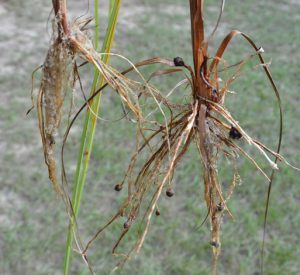
By Les Harrison
Wakulla County Extension Director
The return of consistent warm weather to Wakulla County has many residents thinking about the state of their lawns. Mowing, fertilizing, weeding and patching bald spots are now the focus of homeowners and landscape maintenance professionals.
The choice of turf depends on the preferences and needs of the landscape’s owner. Bahiagrass, Bermudagrass, Centipede, Zoysia, and others selected for their particular traits and appearance.
However, there is one exotic “grass” not on any list of popular spring turf or ground covers. So of course this grass-like weed appears voluntarily and aggressively pushes the desired species to the brink of extinction if left unchecked.
Purple nutsedge, Cyperus rotundus, grows from every possible sunny location with soil. This non-native plant is a rapidly spreading perennial which will take every opportunity to colonize new locations.
The identifier purple is in its name because there is a purple-tinged section of this sedge where it emerges from the ground. The plant is sometimes referred to as purple nut grass because of its long narrow leaves and its erect growth pattern originating from a nutlike basal bulb.
There are other sedges in Wakulla County, but only yellow nutsedge is identified by a specific color. It is sometimes called chufa and is a popular feed for wild turkeys, and turkey hunters.
The dark green, smooth leaves blend in easily with many turf grasses during the spring and summer. Beneath the soil’s surface and out of sight, the root system grows in every direction.
Purple nutsedge’s roots are a series of spreading rhizomes and tubers or bulbs identified as nutlets. Each nutlet sprouts a new bunch of grass-like leaves and continues growing the rhizomes.
The dense population of this sedge quickly crowds out most other plants, but especially turf and forage grasses. It can reach a height of 18 inches on its triangle shaped stem.
The root system’s design assures this plants continued success. If pulled, the rhizomes break off leaving a large number of nutlets to develop and emerge at a later date.
If plowed or tilled, the nutlets are detached and spread to new and inviting locations. Many times nutlets lodge in tillage equipment only to shake loose and deposited in un-colonized locations.
Most herbicides have little effect on this sedge’s hardy root system. Selected pre-emergent herbicides will prevent many of the nutlets from germinating in spring if properly applies.
Wakulla County’s sandy soils provide an ideal growing environment for purple nutsedge. The occasional periods of saturation from storms do not deter this plant’s rapid growth and expansion to new areas.
Purple nutsedge’s extreme competitive nature is a heavy consumer of plant nutrients. It robs rivals of important compounds necessary for their survival, and produces an allelopathic substance which is toxic to some plants.
Purple nutsedge is found in many locales in North America where the environment is hospitable to its growth. The autumn cool and shorter days send this exotic pest into dormancy, but the seeds of next year’s crop, and landscape problems, are just under the surface.
Just like desirable turf in north Florida, purple nutsedge will not grow in heavy shade. Typical of most weeds, it only grows where it is not wanted.
To learn more about purple nut sedge in Wakulla County contact the UF/IFAS Wakulla County Extension Office at 850-926-3931 or https://blogs.ifas.ufl.edu/wakullaco/.
 0
0
